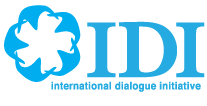On 7 December 2017, the IDI and the Simorgh held a panel discussion in Vienna, Austria titled: Being the Other: Bridging the gap between communities. IDI members Vamik Volkan and Regine Scholz were panelists, Pari Namazie represented the Simorgh and the panel was moderated by Bijan Khajehpour, also an IDI member.
The Simorgh is a non-profit organization with the mission to pave the way for greater engagement and understanding between Iranians and the EU, with a view to promote shared values, common interests and increase mutual understanding and respect between peoples, communities and nations. The Simorgh shared research on the migrant crisis Europe is currently facing and then its own research findings on a recent project titled Being the Other, which explores the Iranian migrant community in Europe. The panelists were then given the opportunity to share their perspectives on Being the Other, from the viewpoint of communities, cultures and countries.
In recent years, Europe has seen a growing number of migrants. As more arrived, the kind gestures of helping people from war-torn and traumatic areas turned to fear and confusion. In the meantime, Europe has witnessed a growing tendency towards the far right and the culture of fear, as witnessed in multiple elections. These sentiments could turn from misperception and misunderstanding to the deeper issues of identity threat, discrimination, hatred and violence.
A central question is how we maintain the European Union’s fundamental values of respect for human dignity, human rights, freedom, democracy, equality and the rule of law, while a growing culture of fear divides us? How do we bridge this growing gap? What is our role, as Europeans, as migrants, as governments, as policy makers and as global citizens in this narrative?
In 2015, 1.3 million migrants, mostly from the war-torn nations of Syria, Afghanistan and Iraq sought asylum in Europe. In 2016, nearly 370,000 refugees and migrants arrived in Europe, most of them by sea. A recent Pew Research Center study conducted on more than 10,000 people from 10 European states showed the growing concern by Europeans with regard to the migrants. The research was titled: “Europeans Fear Wave of Refugees Will Mean More Terrorism, Fewer Jobs”.
Since 1979, waves of Iranians have migrated to North America, Europe, Australia and other parts of the world. Presently there are an estimated number of Iranian migrants between 2-3 million throughout the world, with the highest number being in North America. Migration of Iranians to Western Europe was mainly driven by education and to a lesser extent political reasons. The research done by the Simorgh showed that Iranians integrated well into their new host countries and cultures and were relatively positive about their position in society vis-à-vis other migrant groups. Trust toward other Iranian migrants is surprisingly lower than trust toward native citizens. Except for political parties, most institutions in the new country of residence are mostly trusted by Iranian migrants.
After the research findings were presented, the panel and participants explored different issues:
- The mourning experienced by the migrant, but also the way that what is happening in the host country and in the country the migrant left behind affects the mourning process.
- Prejudice is a part of human experience – the legacy of ordinary stranger anxiety. It can’t be eradicated, but it is important to understand how to deal with it so that it does not become dangerous
- Understanding the Other is a process; we need to understand the dimensions of that process.
- Identities may seem to be fixed, but they too are a process, one that can lead to considerable insecurity.
- The German population today has 22.5% from some migrant background. One parent or another has been a foreigner.
- Migration will continue – we have not begun to see the migration due to climate change. The world needs to adapt and prepare for this as an on-going challenge
- How are society’s less educated members to learn about and be helped to integrate these issues?
- Immigration is traumatic but there is also potentially a glory or a heroism that may push the migrant to take on this big challenge. He might feel many levels of opportunity.
- A migrant takes on these challenges and hardships to change his environment and status. Therefore in his new country, he needs to be in the forefront rather than on the side lines
- Iranian migrants seem to push themselves to achieve more and aspire to higher roles in society.
- When we are faced with a threatened Europe, we have to consider the anxiety the other is experiencing and think what we can do to reduce that.
- We also need to consider that the pace of change is too fast and therefore threatening for them.
- The experience of each migrant community is not generalizable because they each have had different driving forces, different push and pull factors. For example, Iranians migrating in the 70s were the highly educated and industrious members of society, leaving a theocratic regime that felt threatened by them. Ironically, it was their leaving that actually crippled Iran. The Jews migrating out of Germany at the end of WWII were driven by racist factors. The Middle East migration today is caused mainly by economic hardships and flight from war.
- If anxiety in a host country is not managed, it turns to aggression very soon
- Migration affects the psyche. 1st, 2nd and 3rd generation migrants are different, with important inter-generational dynamics to pay attention to.
- The question for us is how can we turn this from migrant/refugee crisis from challenge to opportunity?

There are no comments